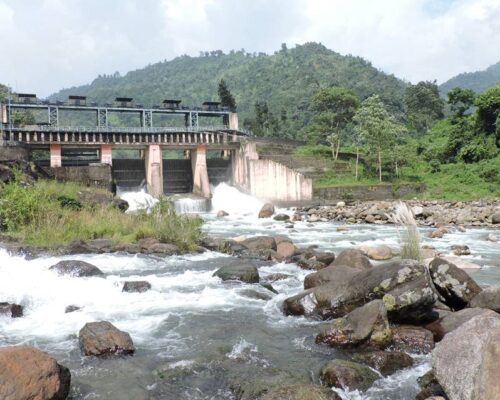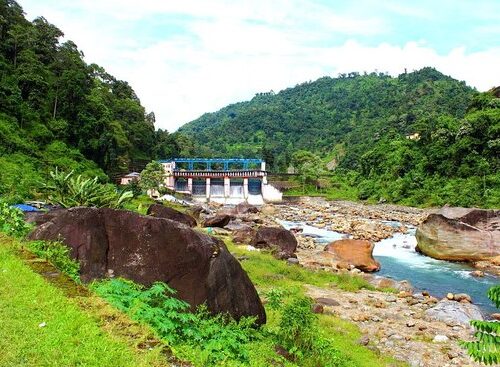Darjeeling
A respite from the hot and humid summers of India, Darjeeling is a popular tourist destination in North-East India. Providing a heady mixture of splendid tea gardens on rolling mountain slopes, meandering toy train rides through the picturesque city, and delectable traditional Tibetan cuisine, Darjeeling works wonders to cater to the gorgeous panorama of the Himalayas.
There is a reason the city is known as the ‘Queen of the Himalayas’. The lush green slopes dotted with women plucking tea leaves is a sight as mesmerising as no other. There are over 86 tea estates in Darjeeling that are responsible for producing the worldwide famous ‘Darjeeling Tea’. Have a cup of locally brewed chai at the tea estate, or get down amidst the plantations to pluck a few tea leaves yourself, you are free to take your pick!
A previous summer capital of India under the British Raj, Darjeeling has come of age as one of the most sought after hill stations in India. Famous for its beautiful tea plantations and the quality of Darjeeling tea, Darjeeling is a delight for all kinds of tourists. The toy train established back in 1881, still runs in this part and is also one of the UNESCO World Heritage sites. Beautiful colonial architecture including mansions and churches dot this little beautiful town. Filled with people from Tibet, Nepal, nearby Indian states and the Gorkhas, Darjeeling is brimming with cultural diversity. The third highest peak in the world and the highest in India, the Kanchenjunga peak is clearly visible from here and you can enjoy a panoramic view of the peak. Some of Darjeeling’s most popular attractions include monasteries, botanical gardens, a zoo, and the Darjeeling-Rangeet Valley Passenger Ropeway cable car which happens to be the longest Asian cable car. Darjeeling is a wonderful place to walk around and explore the tea estates, villages, and markets.
Toy train from NJP to Darjeeling-
Darjeeling Toy train is one of the main attractions for the tourists coming to this region. This train covers a distance of 88 Km in six and half hour journey.This train has got first class setting and second class setting compartments.Toilets are available in each compartment. The main train Darjeeling Mail now runs by a Diesel engine with few compartments. There are steam engines still maintained by Darjeeling Himalayan railway but they operate mostly at the Darjeeling end for joy rides. This is one of the world heritage sites as mountain railways of India listed at UNESCO.
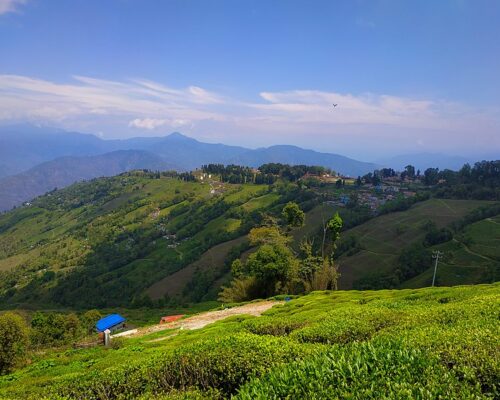
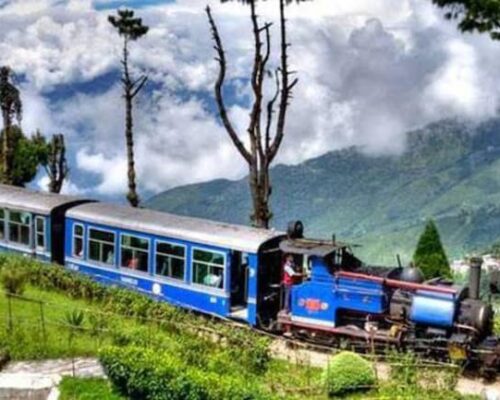
Kalimpong
Kalimpong is a beautiful place with great attractions. This sleepy little town is situated at an altitude of 1,200 meters, some 50 km to the east of Darjeeling. It once used to be the hub of the trans-Himalayan trade between India and Tibet when merchants used to ferry commerce by mule caravan over the Jelepla pass on the Sikkim-Tibet border.
The places to visit are Kalimpong Arts and Craft Center for handicraft goods; Tharpa Choling Monastery, a repository of old scriptures, and documents; Thongsa (Bhutan) Monastery, the oldest in the area; Dharmodaya Vihar, a Nepalese Bhuddhist Temple; Parnami Mandir and Mangal Dham; Durpin Danda from where the mountain ranges of Sikkim, including Jelepla, Tiger Hill and the confluence of the Relli, Riang and Tista rivers can be views Zong Dog Palri Fo Brang Monastery at Durpin Danda; deolo View Point for magnificent views: and Kalimpong famous flower nurseries.
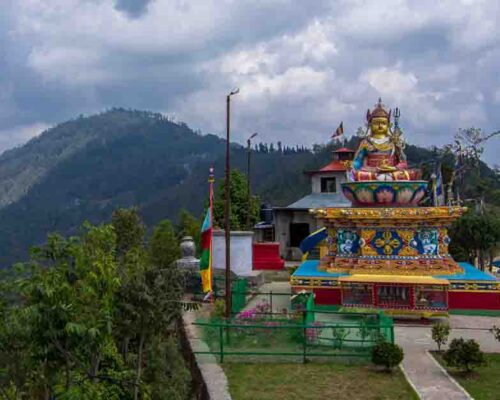
Lava Lolegaon
Nestled amidst the dense forests and deep valleys of the Eastern Himalayas, the serene hamlet of Lava (7200ft) offers excellent opportunities for the tourists to enjoy nature & wildlife more intimately. Situated in a close proximity to Neora Valley National Park, this is one of the very few places in West Bengal which is endorsed with the outstanding views of Mt. Kanchenjunga along with the rare species of orchids, pine, birch, juniper trees, the colorful canopy of Rhododendrons, and Himalayan flora & faunas. Besides, the inaccessible terrains of the region are not less than a challenge for nature lovers and trekkers.
From New Jalpaiguri (NJP), the distance to Lava is about 105kms via Kalimpong and 119kms via Gorubathan. It takes about 3.5 hours by car from NJP. From Kalimpong, both Lava and Loleygaon are close and ideal for day trips. Lava is about 34kms along Rishi Road and Loleygaon is further 22kms away (i.e. 56kms from Kalimpong).
New Mal Junction is the nearest railway station from Lava. Distance 58 km & 70 km from Rishop.
Places to see-
1. Lava Monastery
2. Tiffin Dara and Ghanti Dara
3.Changey Falls
Loleygaon at an elevation of 5500ft is a small Lepcha village in the Kalimpong district of West Bengal, at the extreme end of a Himalayan ridge. Located at a distance of 24 Km from Lava, covered with thick mist and floating clouds, it is a place which will make everyone fall in love with its unique enchantment and tranquility. The place appears at its best when visited from October to April. You can expect clear skies and huge greeneries.
Places to see-
1. Neora Valley National Park
2. Canopy walk along the hanging bridge
3. Lolegaon Viewpoint
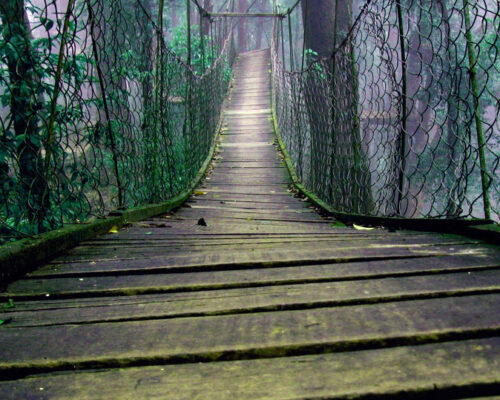
Rishyap
Rishyap is a small village perched at an altitude of 8500 ft in the lap of Eastern Himalaya. The hamlet is also at a close proximity to Neora Valley National Park.
‘Ri’ stands for mountain peak and ‘shop’ for old tree. Rishop also spelled Rishyap is small but a popular tourist spot. The undiluted spell of staying in a hill village among chirping birds and waking up with the view of the Majestic Kanchenjunga is the primary reason behind the popularity of Rishyap. The blue mountains by its side and snow-covered peaks rising at the intervals are worth watching. Besides, Rishop also houses some unknown flowers, deep valleys, and areas for treks. February, June, July, and October to January are the best months to visit this alluring little hamlet.
Distance from Lava is 12km. Trek through jungle-4km.
Places to see-
1. Neora Valley National Park
2. Majestic Eastern Himalayan Peaks.
3. Tiffin Dara

Kolakham
Kolakham is a small village nestled in Neora Valley Reserve Forest facing Eastern Himalayan peak. The place located at an altitude of 6500ft is a paradise for nature lovers. Kolakham Nature Retreat set amidst Oak, Rhododendron and Pine forests, and overlooking the snow-clad Himalaya, this is an ideal getaway for those who wish to explore pristine mountain wilderness.
Kolakham is a favourite location for adventurous tourists who like to take the challenge to discover the still unknown territory of Neora valley forest. The majestic view of Kanchenjunga from Kolakham village, the jungle trail in Neora forest, the scenic beauty of Changey waterfalls is a once in a lifetime experience for anyone. Enthusiastic people can refresh their mind with a short trek around Kolakham.

Charkhole-Jhandi
Charkhole is a newly developed offbeat tourist destination in Kalimpong district. This place is 15km away from Lolegaon/Kafer and 26km from Kalimpong. From the top of Charkhole Hill get a complete 360-degree view of Mt. Kanchenjunga and associated peaks. The dense forest of towering pine, oak, fir, the variety of rhododendrons, the sweet melody of rare birds, will accompany you throughout the journey towards Charkhole.
Surrounded by evergreen forest of Sal and Pine tree Jhandi is a scenic valley located in the Dooars region of West Bengal. It is 87 km from siliguri and around 09 kilometers from Lava. Jhandi offers a panoramic view of Mt. Kanchenjunga and Mahananda River valley. Jhandi is covered with tea plantations and forests.The village is substantial in lush, tropical evergreen trees, Sal and Pine forest, which are home to some of India’s rarest Himalayan flora and fauna.
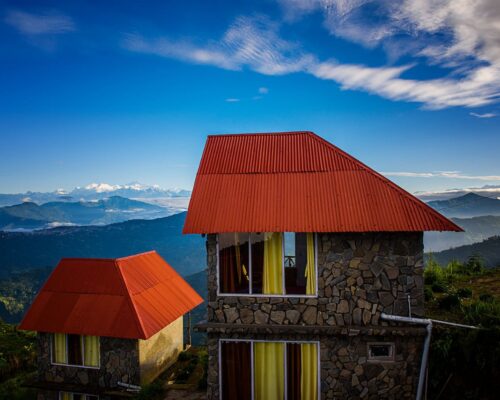
Samsing Suntalekhola
Samsing in Dooars is a serene village with lush vegetation, vast stretches of tea gardens, orange orchards, forests and is surrounded by hills. Samsing is located at an altitude of 3,000ft and at a distance of 17kms from Chalsa. Suntalekhola is another hamlet 4kms ahead and known for the WBFDC lodge in a lush garden setting offering nature stay amidst dense forest. Rocky Island is a nearby small village 3kms from Samsing located by the bank of river Murti. It’s ideal for camping and indulging in light adventure activities like cave exploring and rock climbing by the river side as well as trekking.
If you are a nature lover and looking for scenic valley views, miles of tea gardens, quaint villages, mountain streams, forested landscapes, nature trails, and all in quiet solitude… then these are perfect destinations for you. All these places can be visited on a day trip from Gorumara National Park (i.e. from Lataguri or Murti). Many nature lovers also prefer to stay overnight at one of these places.

Gorumara National Park
Gorumara National Park is the most desired destination in Western Dooars. It receives the maximum number of visitors in Dooars. The park is situated just at the foothills of Eastern Himalaya in Terai region, on the floodplains in Murti, Raidak. Jaldhaka, a tributary of Brahmaputra flows just beside the National Park. Gorumara has mixed vegetation of forest and grassland. It is famous for its good population of One Horned Indian Rhino. The Ministry of Environment and Forest has declared Gorumara as the best among the protected areas in India for the year 2009. Gorumara was declared a reserve forest in 1895. In 1949 it was given the status of a wildlife sanctuary. Later on Gorumara was declared as a National Park in 1994. Gorumara National Park is spread over an area of approx 80 sq km. Gorumara forest was declared National Park in 1994. This forest is enriched with one horned Rhino, Gaur, Elephant, Chital, Sambar deer etc. Number of beautiful destinations like Jhalong, Bindu, Chalsa, Samsing, Suntaleykhola can be visited from Gorumara National Park.
Chapramari is a forest in Dooars area of North Bengal. The forest is a continuation of the Gorumara forests. The two forests are separated by the Murti river which passes through the otherwise continuous forest. Whereas Gorumara is a National Park, Chapramari is only a wildlife sanctuary.
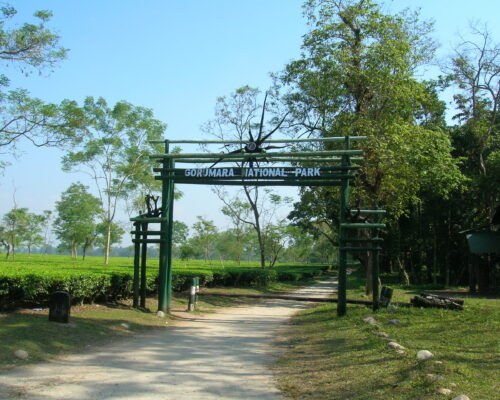
Jhalong Bindu Jaldhaka
Throughout its journey Jaldhaka has created several tourist destinations in Dooars. Most important among them from a tourism perspective is the Jaldhaka Valley. The valley of Jaldhaka, at 1500ft above sea level is an old tourist destination that has gained in prominence in the recent past. Situated on the hill section of Gorubathan under Kalimpong subdivision, it is cut off from the rest of the district by a mountain ridge and is separated from Bhutan by Jaldhaka River.
A small picturesque hill village on the Indo- Bhutan border Bindu is a tourist point in lower Kalimpong foothills. The journey to Bindu via Chalsa-Khunia-Jhalong is a fascinating one as the road passes through the beautiful tea gardens, high forests, river valleys and small quiet villages.
Jhalong is a small village situated on the banks of river Jaldhaka, near Indo-Bhutan border in the Kalimpong district in West Bengal. Bird lovers can enjoy a varied collection of hill Birds including Kingfisher, Brown Dipper, Redstart, Laughing Thrush as well as migratory waterfowl here. Jhalong is very popular among offbeat enthusiasts and those who are interested in nature vacations. Jhalong is situated on the foothills of the Himalayas and there are numerous activities that visitors can engage in. It is a popular tourist destination just 12 km ahead of Bindu.
Jaldhaka is a charming landscape with nature at her mystic best. At 1500 ft above sea level Jaldhaka river valley is a prospective tourist destination of Dooars. The river valley is located under Kalimpong district by a mountain ridge of Neora Valley National Park and is separated from Bhutan by the Jaldhaka River. The more important villages of Jaldhaka valley and its surrounding area includes Jhalong, Bindu, Paren, Gairibans, Godak, Todey, Tangta, Rongo, Maurey etc. Some of these villages such as Rongo forest, Todey Tangta etc. are not exactly on the Jaldhaka valley but on the nearby hills, but together they form part of the same tourist circuit.
